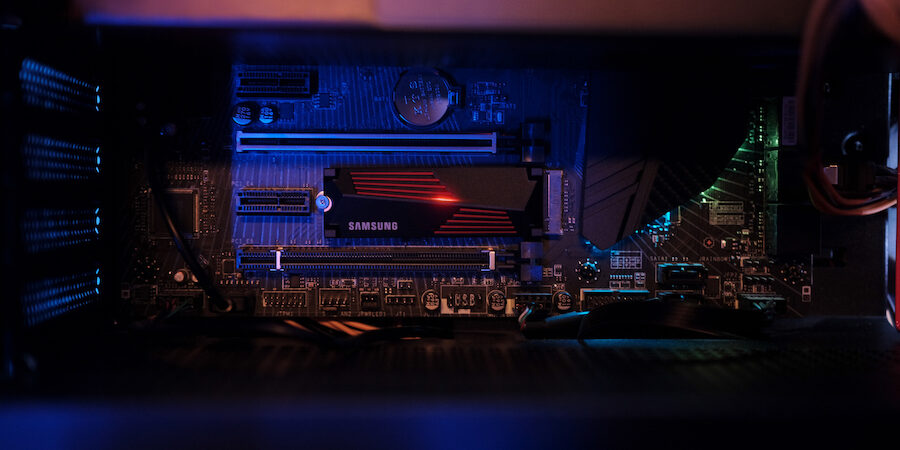Anyone who has ever installed a traditional hard disk drive (HDD) is familiar with the Serial ATA (SATA) interface. Designed specifically for HDDs, SATA sends data from the storage device to the computer motherboard. While it’s still a popular connectivity interface, the speed at which it transfers data — the fastest SATA specification transports data at 560 MB/s — isn’t fast enough for many of today’s applications and operating systems. Even SATA-based solid state drives (SSDs), which are three to four times faster than SATA-based HDDs, simply can’t measure up for some use cases. There is a fix, though: non-volatile memory express (NVMe®), which individuals and companies of all sizes are using to increase the performance and efficiency of their SSD drives.
What is an NVMe drive?
The NVMe® specification was specifically designed to work with SSDs to take advantage of their enhanced features. The benefits of NVMe vary, but they all relate to enabling the speed and functionality of SSDs.
It can do so because the NVMe specification is much faster than SATA, according to NVM Express, the working group of more than 100 technology companies that were behind the development of the NVMe specification. This translates into enabling SSDs to transfer data faster data and with lower latency — the time between when a user or system requests data and when it is delivered. And the data transfer difference between SATA and NVMe is huge, according to the group. “Current PCIe 3.0 x4 NVMe SSDs are 6–7x faster than a SATA SSD,” the group explains.
And yet when it comes installing NVMe SSD, there’s not too much difference from how you would install a SATA drive. An SSD drive connects to a system via a PCIe® bus and either an M.2 or U.2 slot located right on your system’s motherboard. Once you find the right slot for the drive, you simply slide it in and click it into place. When you power up your system you may be asked to install or update drivers, but that’s basically it.
Get your complete guide to SSD management
Discover how to effectively adopt and manage SSDs in your organization with this ultimate guide. Download Now
Installing a SATA-based internal drive also requires you to open your system, but the drive plugs in via connector cables rather than sliding into a slot. Though when you turn on a system running an NVMe drive, you’ll see the difference in speed. The simplified speed protocol of NVMe Gen3 is approximately 3,500 MB/s as opposed to SATA’s approximately 560 MB/s. In addition, according to TechTarget1, “NVMe SSDs have a latency of only a few microseconds, while SATA SSDs have a latency between 30 and 100 microseconds.” This means that the time it takes between when the CPU makes a request of the SSD and the time the data is delivered is perceptively less for an NVMe-based SSD drive.
The specification’s speed comes partially because it uses parallelism in data processing. This means that instead of having to transmit a limited number of I/Os at once, NVMe can handle multiple queues and commands simultaneously — enabling applications and use cases that require low latency and fast processing, such as gaming, video processing and editing, as well as high-performance computing tasks like computer-aided engineering, machine learning, 3D modeling and financial computations.
The benefits of using NVMe SSD technology
NVMe SSDs such as Samsung 990 PRO are perfect for anything that requires real-time processing. With sequential read/write speeds up to 7,450/6,900 MB/s, Samsung 990 PRO, which connects via an M.2 slot, can nearly top PCIe 4.0’s maximum speed. And since it comes in three capacities — 1TB, 2TB or 4TB — it’s perfect whether you’re interested in gaming or setting up a server or lab within your office.
Using NVMe as a scientist, or anyone who uses high-performance computing where SSDs are used to store data and datasets, is a no-brainer since the specification makes data retrieval fast, speeding up computations and data analysis. The specification is also key to anyone who is using it as part of a data center or cloud computing paradigm. Remote users have issues with internet bandwidth at times. They shouldn’t need to worry that their requests are facing bottlenecks from the hardware that stores their data.
Gamers and anyone who works with video will also see a huge difference with their use of an NVMe-based SSD like Samsung 990 PRO since it’s optimized for intensive tasks. Scenes will load faster, lag is reduced significantly and gameplay is more enjoyable when you don’t have to worry that your system doesn’t move as quickly as your hands and eyes do.
While there’s still room and use cases for SATA-based drives, it’s becoming increasingly clear that NVMe is important for anyone who values blazing-fast speed and performance for their SSDs.
Explore Samsung’s comprehensive SSD portfolio to help you identify a business data storage solution tailored to your specific needs.
1 TechTarget. “NVMe (non-volatile memory express).” Jan 26, 2024.








